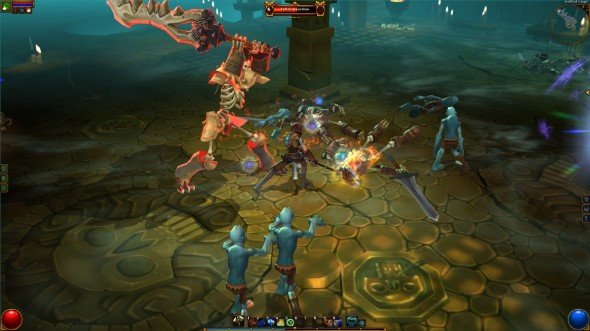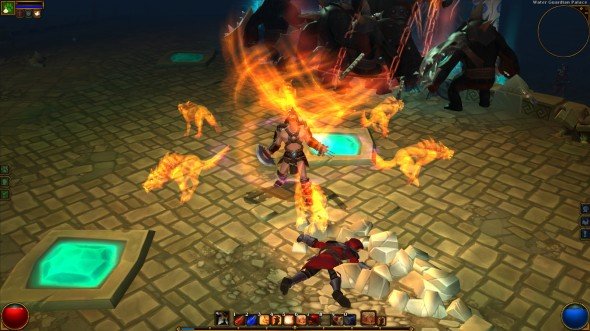Torchlight 2 preview

This article originally appeared in PC Gamer UK Issue 231.
When news of Diablo 3's real money auction house broke, gamers responded with the inevitable arguing and outrage, but amongst it was one shared opinion: if it did cause a problem, people would simply play its action-RPG cousin Torchlight 2 instead.
Max Schaefer, CEO of Torchlight developers Runic and co-designer of Diablo and Diablo II, explains their philosophy. “We want to establish that you can have a great, compelling, fun game to which you don't need to make a long term financial commitment,” he says. “We also want to be able to move onwards – if you charge subscriptions and micropayments you commit to years of support and development on the game.”
Torchlight II is the uneasy adolescence between the fast-paced, loot-crazed Torchlight and the plans for an MMO set within the same world. “It makes an excellent stepping stone to MMO development,” says Schaefer. The original Torchlight was beloved enough that players begged for a multiplayer component, so this time around you'll be able to fight with friends, either online or over a LAN.

But that's not the only difference between the two games. “We didn't want to make it seem like we were simply tacking multiplayer onto Torchlight,” says Schaefer, “so we made the decision to start from scratch on characters”.
In Torchlight II, there'll be four new classes to choose from – the ranged, “lowmagic” nomad Outlander, the meleefocused, engineering-themed Railman, the fast-attacking Berserker, who'll come with a selection of animal powers, and a mystery fourth character. Runic wouldn't reveal too much about this one, but fantasy RPG tradition dictates that some form of mana-guzzling sorceress would fit nicely into that lineup. Each will have customisable male and female variants.
Rather than simply giving players a new set of dungeons to explore, Torchlight II is expanding above ground. The linear, claustrophobic caverns of the first title are being augmented by overworld environments that'll include deserts, snowy temples, dwarven battlefields, and haunted forests and swamps. Each has a full day/night cycle and random weather.
Keep up to date with the most important stories and the best deals, as picked by the PC Gamer team.

Those environments are far larger than in Torchlight. The largest levels in the first game were comprised of six to seven 'chunks' in a random linear order, but in Torchlight II a typical area will be comprised of as many as 23 'chunks' in a grid. There'll still be an entrance and an exit, but there'll also be hidden corners to explore, rivers to navigate and landmarks to investigate. “The world is bigger and deeper,” Schaefer says.
That world is split into three major sections, each with its own different hub town. Random events and tasks will pop up for your character to deal with in whatever way they see fit. Those will range from a broken down wagon beset by monsters to a slave camp that you have to burn down to free those trapped within. Each landmark in the game will have some form of mini-boss tied to it, marking a major increase in the number of boss fights that you'll need to deal with.
Guiding you will be a bulked-out plot. Whereas the first game's story was largely incidental to the action, its sequel aims for a more balanced approach. “We don't want to change the action-oriented nature of the game, but we want the story to feel more immersive and compelling,” Schaefer says. “This time we even hired a real writer!”

The sequel has been delayed a little by the process of getting the first Torchlight out on the Xbox 360, but PC gamers shouldn't feel left out. “It gave our artists and level designers a bit more time to make cool stuff,” says Schaefer. “Also, we made some technological optimisations based on the necessities of porting to the Xbox.” That should mean that Torchlight II will have the same low system requirements of its predecessor, despite an increased polygon count and larger environments. Schaefer won't commit to whether it would come with the much-loved netbook mode of the first game though. “We'll wait till its done before saying anything about netbooks, just to be on the safe side.”
By starting with the same basic technology and tools as the original game, the focus this time around can be placed more squarely on more and better content. “We've got a great running start. The development cycle will be around two years, which is almost twice as long as we took on Torchlight,” Schaefer says.
Don't dismiss Torchlight II as a mere stepping stone between the purity of Torchlight and the endgame of an eventual MMO. The first game distilled the action-RPG genre into a simple easy-tounderstand package, but Torchlight II promises to perfect that package with the addition of multiplayer, more compelling environments, and a storyline worth paying attention to. If Runic can pull it off, that long wait for Diablo III might not seem so bad after all.

